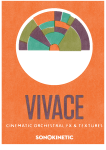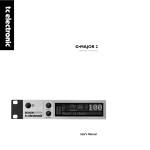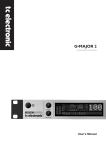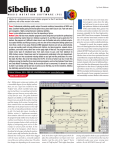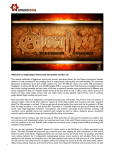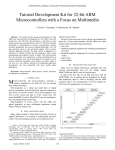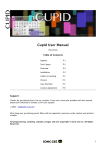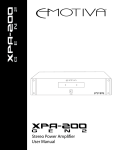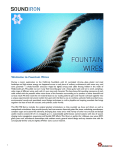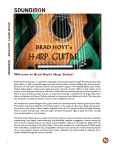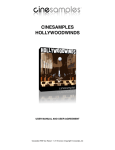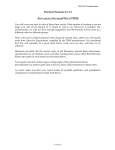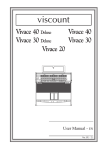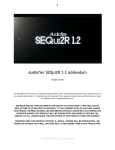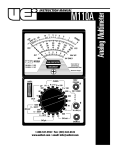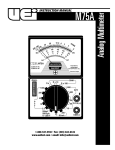Download English - Sonokinetic
Transcript
Cinematic Orchestral FX & Textures “Less is More” Sonokinetic BV © 2013 Minimal With Minimal, Sonokinetic BV delivers the fourth installment in our current range of orchestral instruments. We have listened to our users, and built an entirely new system from the ground up, defining what we think is a revolutionary novel direction in orchestral pattern-based sampling. Minimal would suggest a particular music style, and many of the patterns available in this instrument are very well suited for that style. However, we’d like to stress that this is indeed a very flexible instrument, capable of enhancing a broad range of musical arrangements and compositions in a wide variety of styles. Where Minimal differs from libraries like Tutti and Vivace is in its section-based approach. All phrases are recorded per orchestral section and can be used separately or together and in any combination, allowing for a great deal of variations at your fingertips. The first thing that would strike you is the non-apologetic interface style without any gloss. Apart from this being a respectful nod to our Dutch art heritage on the outside, it also very much references the “form follows function” approach that Dutch design is famous for. There are no superfluous elements and we’ve arranged everything in an intuitive way. You have every control in one screen within an uncrowded workspace. You might not suspect it from just looking at it, but there are a lot of complex functionalities at your disposal from this one screen. Discover more about those in the detailed descriptions right here in the user manual and on the tutorial videos available on our website: www.sonokinetic.net. Recordings for Minimal took place in Zlin, Czech Republic, in the same hall and with the same team responsible for recording Tutti and Vivace. The performances have been edited with the same meticulous attention to detail and quality. Many innovative functions grace this instrument, mostly under the hood, as we believe that technology is at its best when you don’t notice it. One of the functions that might need a bit more introduction is the harmonic shift function. This element of Minimal can lead to great sounding results and also serve as a very rewarding inspirational tool. So please read and digest the part of this manual dedicated to that function. More visibly, and in lieu of popular request, we have found a way to greatly improve the score view. Despite the pixel restrictions of the Kontakt window we’ve managed to squeeze in a clear and accurate score view, although you can still order a digital full-scale copy of the score, if you so desire. We, at Sonokinetic BV, are very proud to introduce Minimal to you, and can’t wait to hear the amazing things you, our valued customer base, will produce with it. Sonokinetic has established a name as one of the best value & quality sample producers and with this product we’d like to underline that statement. We stick with our unbeatable pricing module and high quality sampling. We wish you the best inspiration and creativity. With warm regards, The Sonokinetic Minimal Production Team CONTENT 16 Bit version 24 Bit version 10.8 Gb sample pool, 33800+ samples 21 Gb sample pool, 33800+ samples 4 recorded orchestral sections - Strings 52 players - Woodwinds 12 players - Percussion (two marimbas, xylophone, piano and celesta) - Brass 11 players 4 recorded microphone positions - Close - Decca tree - Wide - Balcony and a proprietary stereo mix for the ‘lite’ instrument Individual section controls include - Volume - Pan - Rhythmic Shift double/half/triplets - Harmonic Shift - Crossfade adjustments Custom designed interface with enhanced score display Time Machine Pro capability Custom chord recognition and Harmonic Shift capabilities Advanced Purging system Native Instruments Kontakt Player Library license Royalty and copyright free content license Minimal Reference document (PDF) Artwork: “Minimal” DVD cover. Designed by Pavel Fuksa All files in 44.1 kHz, 24 Bit and 16 Bit NCW format. Programmed for Kontakt 5.1 and up QUICK START GUIDE The main interface of Minimal has four fields, which all function in exactly the same way; Play major and minor triads in this area to play the current selected preset Up to seven presets per instance of Minimal can be stored on the yellow keys in this octave for instant use, the red key marks the preset that’s currently selected Panning Slider Volume Slider Click on the instrument graphic to choose an orchestral section for that field Load different phrases by clicking on the graphic representation of the phrase Choose between different phrases characterized by the current graphic representation THE INTERFACE The main interface window for Minimal contains all the controls in just one place. The interface is split into 4 fields, each of which can be assigned a pattern and variation from an orchestral section. Each of these fields can have distinct panning, volume and other settings. The settings for all four of these fields are saved under 7 different presets which can be changed with keyswitches or by clicking within the interface itself. Presets Minimal has 7 user presets, each of which can be assigned up to 4 different fields. The presets can be selected either by clicking the keys in the interface (which will glow yellow) or with the keyswitches from C3 to B3. Change presets from 1-7 Purging The small dots on the keys indicate which presets have their samples loaded or purged. Any dot can be clicked to purge samples and conserve RAM. A black dot indicates that a preset is active and samples loaded. A white dot indicates that although the settings of a preset are stored, the samples have been purged. Fields There are 4 fields within Minimal. In the interface the field areas are different sizes but they all function in the same way. Each field can be assigned an orchestral section, either strings, brass, woodwind, percussion or mixed orchestra. Click on the instrument graphic to change orchestral sections. Once assigned, the field colour will change depending on the section loaded. Use the power button in the top left of each field to turn the field on or off. This can also be achieved with keyswitches from C0 to G0 where playing a white key will turn the field on and black key one semitone higher will turn it off. Switch fields on and off: white key=on black key a semitone above=off Phrase Selection Select a phrase in the field by clicking the graphic representing a pattern. A secondary window will open allowing you to choose a different phrase. Be aware that different orchestral sections have different numbers of phrases available. Some of the phrases are specifically composed to compliment each other and as such have the same graphic. To exit this window, click the back arrow. Many phrases have variations. These are indicated by several dots in the bottom right of the field. Click any dot to select an alternate variation of the phrase. Sometimes the difference is subtle, sometimes it’s a very different sounding phrase, that still corresponds with the graphic representation. Panning & Volume The panning control for each field sits in the top bar of each field. Drag the slider to change this. Drag the slider at the left-hand side of each field to change that field’s volume. By default the MOD wheel of your MIDI keyboard will control the output volume of the whole instance of Minimal. However, this can be disabled within individual fields by clicking the MOD wheel button shown here. This function allows greater expression as you can keep the volume of one or more fields constant whilst changing others with the MOD wheel. Use this to create interesting, constantly changing phrases and crescendos / decrescendos. Sample crossfade Due to the flexible nature of the phrases within Minimal and the wide variety of tempos it may sometimes be necessary to adjust the crossfade of phrases when a new chord is played. The slider underneath the field title (STRINGS, WOODWIND etc) enables you to do this. Drag to the left for shorter crossfade times and to the right for longer crossfades. This control will help to smooth out or tighten up transitions when used carefully. Tempo syncing & rhythms All phrases in Minimal have been recorded at 110 BPM. Minimal will sync to the host tempo of your DAW and stretch the samples accordingly using Time Machine Pro. For more flexibility in playback you can switch individual fields into half, double and triplets by clicking the note button. The button image will change to indicate how the timing has changed. Use mixtures of alternate timings in different fields to create complex rhythms. Be aware that some phrases in Minimal have been composed in a variety of time signatures including 3/4 and 7/8. There is just one limitation with rhythm adjustments in Minimal: If you choose exactly the same section, phrase and variation in two or more fields and change the rhythm within one of them, then they’ll all change. This can be remedied by using another instance of Minimal on a new track. Harmonic Shift A unique feature of Minimal is the Harmonic Shift function. This allows the user to play phrases simultaneously in different, but related, keys. This function can be used to access more complex chords other than the standard major / minor phrases within Minimal. Harmonic Shift can be turned on or off for each field with the +/- button but it’s only useful if you turn it on in some fields and off in others. (displayed state is ‘off’) The keyswitches from C5 to B5 control the relative root pitch of the shifted phrase. The base key and shifted key are shown at the bottom right of the interface Harmonic Shift relative pitch Note that the Harmonic Shift only designates an interval, relative to C. So for example, if you play an Em chord, and then use the keyswitch at D#, it would add a minor third up from Em, resulting in a Gmajor phrase being added. The relative pitch keys are as follows, shown with an example relative to C major and minor: C MAJOR +1 C# min +2 D maj +3 D# maj +4 E min +5 F maj +6 F# min +7 G maj +8 G# maj +9 A min +10 A# maj +11 B min C MINOR +1 C# maj +2 D min +3 D# maj +4 E min +5 F maj +6 F# maj +7 G maj +8 G# maj +9 A min +10 A# maj +11 B maj The effectiveness and musicality of the Harmonic Shift varies, depending on the phrases you assign to each field. Experiment with different phrases and Harmonic Shift values to create interesting and surprising textures and note combinations. PLAYING MINIMAL The basic method of playing Minimal is to play three-note triads in the keyrange C1 to G2. The chord recognition system will automatically recognize inversions and will choose a major or minor phrase based on the MIDI chord played. A few phrases will be the same for both major and minor playback. For example, those phrases which use only root or 5th notes. Play major and minor triads Release samples Sample retrigger Once you’ve played a chord it’s possible to sustain it by holding just one of the notes. This enables easy switching to new chords without any gap in the playback. Chords can also be held by using a sustain pedal. Alternatively, a chord can be sustained by holding any key down in the playable area, thus allowing changes between chords without shared notes. Release samples Minimal contains release samples for all phrases. These give a realistic and appropriate release note or reverb tail when keys are released. The release samples become especially important if you choose to truncate the playback of phrase, giving a realistic ending to the phrase. The release samples can be turned on and off with keyswitches at respectively F4 (on) and G4 (off). Sample Retrigger When playing different chords, you have the choice whether to retrigger the phrases or to simply continue the phrase but in the new root key. This function is controlled by keyswitches D6 (retrigger) and E6 (continue). Microphone positions The samples for Minimal have been recorded in the same hall as sister libraries Da Capo, Tutti and Vivace. As such, Minimal has similar options for microphone mixing; Close, Decca Tree, Wide and Balcony. It is possible to use just one microphone position or mix between two different positions. These different positions can be selected by clicking on the name and mixing is controlled with the red arrow underneath. The crossfade operates in such a way that the central position will play both microphone positions at full volume. Microphone mixing options are global and apply to all presets and sections. Note that activating multiple microphone sections puts additional strain on CPU usage. If you plan on using just one microphone position, set the other to NONE to conserve CPU and RAM. Minimal Tutti We have included a version of Minimal named Minimal Lite.nki This version functions in exactly the same way as the full version of Minimal but with just one specially mixed Tutti microphone position. Use this patch when you want just one pre-mixed version of Minimal which will conserve RAM and CPU. Notes on the .nki files As well as the standard version of Minimal (Minimal.nki) we have provided some other .nki files, which you may find useful. Please note that the ‘Lite’ versions of these files are exactly the same but use only the Tutti mic position, as described on the previous page. These ‘fast’ and ‘slow’ pattern .nki files contain 7 preprogrammed presets which showcase Minimal’s usefulness in a variety of different genres and speeds. Of course, you can edit the presets in the same manner a standard instance of Minimal. These .nki files are merely useful jumping-off points to get you started quickly and inspire your own combinations of phrases. Score View True to the ‘minimal’ style of this library the phrases are represented by graphics instead of actual notations. However, the original notation can be accessed by clicking on this part of the interface. This will open a large Score View, where you can view the currently selected phrases in their notated form. Click on the keys of the interface keyboard to access transposed notation You can click on the small windows representing the four different fields on the right, to choose which field you’d like the score displayed. Then click on the key on the keys of the keyboard to change the displayed key, and when available choose between MAJOR or MINOR. We’ve chosen to make the selection of key and modality a manual process rather than an automated one this time, as automating this could introduce anomalies in playback, especially on lower spec’d systems. You can either click on the back arrow or anywhere in the score area to return to the main interface window. Managing CPU and RAM Despite the name, Minimal is a huge instrument and pushes Kontakt to its limit in terms of size and processing. Therefore, it’s useful to know how to limit the memory and processor impact of Minimal within your own system. Although we’ve covered some of these aspects already, the following processes will help to conserve RAM and CPU. • Use the virtual keyboard at the top of the interface to purge any samples from presets that you’re not using. • Deactivate the release samples (this will halve the number of voices used) • Use only one microphone position and set the other to NONE • Choose the Minimal Lite.nki patch instead of the full version of Minimal Tips and Tricks • Don’t forget that you can use identical orchestral sections in each field. For example, you could have 4 different string sections if you like, all playing different patterns. • All sliders can be set to their default position by holding cmd / control whilst clicking. • The crossfade slider also applies to the smoothness of the fades in retrigger / continue mode and harmonic shift mode. • You can right-click on any slider within Minimal to assign a MIDI CC controller. This is especially useful for the individual field volume sliders as it then gives even greater flexibility to mix and change the relative volumes of the four fields as the phrases play. • Harmonic Shift is one of the most powerful features of Minimal. But it’s only effective if it’s switched on in some fields and off in others. Changing the relative key of the harmonic shift partway through a phrase can create some unusual effects. Especially if you turn off the retrigger sample function. • Please refer to our online tutorials concerning Minimal. We offer dedicated video tours concerning this instrument. Due to the nature of orchestral instruments you may sometimes find that you will hear unwanted attack portions of the currently playing chord when changing to a new chord. This is especially true for some slower string and brass phrases. There are a number of ways to remedy this: • Reduce the crossfade time of the field so that the end of the current chord sample is faded out quickly, before the new one comes in. • Adjust your MIDI notes so that they finish approximately half a beat before the new chord starts. The small gap will be filled by a release sample, avoiding the attack portion of the current chord. • Offset your MIDI notes by a few milliseconds. Also, try avoiding using quantisation and experiment with timing chord changes in different ways. Playing chords in by ear often works more effectively than strict quantisation. Kontakt 5.2.1 bug notes By default, Minimal uses 16 HQ voices. If you are experiencing playback dropouts or clicks you may need to change this setting. In the full version of Kontakt click the wrench icon and navigate to the Instrument Option > Voice Handling. You can then increase the HQ Mode Voice Limit to suit your needs. Experienced Kontakt users may be aware of the Batch Resave function within Kontakt. Native Instruments are aware of a bug in version Kontakt 5.2.1 where the HQ Mode Voice Limit is reset to 4 after a Batch Resave. This is not enough HQ voices for Minimal to function correctly. We would not recommend implementing a Batch Resave until a future update of Kontakt resolves this bug. Unfortunately this bug with Kontakt also appears if you save a project and then reload it at a later date. You will need to increase the Minimal HQ Mode Voice Limit from 4 to at least 16 to avoid dropouts. TROUBLESHOOTING Minimal is a large instrument with a myriad of options and functions. To make sure you get the best from Minimal, please read the manual thoroughly and use this troubleshooting guide. There are comprehensive walkthrough videos at http://www.sonokinetic.net where you can also send a support ticket for further technical help. • I’m pressing keys but no sound is coming out Minimal has a chord recognition system. Make sure that you are playing major or minor triads in the keyrange C1 to G2 (the blue keys on the keyboard). Ensure that at least one field is switched on and that the volume slider is raised. Check if the currently selected preset is unpurged (the little dot in the keyboard is black) • I am getting gaps between phrases when I change chords You can use the sustain pedal whilst playing to prevent sample phrases being released until the start of a new chord triad. Alternatively you can hold suspended notes from one chord to another to prevent this gap. • The endings of phrases is very abrupt Turn on the release samples using keyswitch F4 • I’ve turned on Harmonic Shift but it doesn’t do anything Harmonic shift can only be heard working when some fields have it turned on and some have it turned off. The keyswitch at C5 plays all fields at their root pitch and will have no effect on Harmonic Shift. Use the keyswitches from C#5 to B5 to hear a change. • I’m hearing clicks and pops on playback Minimal is a large instrument and pushes Kontakt to its limit. The clicks and pops will be a CPU issue with your system. To ease CPU usage, use the Minimal Lite.nki or turn one of microphone positions off. Disabling the release samples also eases CPU. By default, Minimal uses 16 HQ voices. In the full version of Kontakt click the wrench icon and navigate to the Instrument Option > Voice Handling. You can then increase the HQ Mode Voice Limit to suit your needs. • I saved a project using Minimal but when I reload the project it sounds different Check the version on Kontakt that you’re using. If it’s version 5.2.1 then a bug within Kontakt will reset the HQ Voices to 4 upon reloading a project. This means that some samples are being prevented from playing by the low voice limit. In the full version of Kontakt click the wrench icon and navigate to the Instrument Option > Voice Handling. Increase the number to at least 16. Future updates of Kontakt should solve this problem. For more information check our website: http://www.sonokinetic.net Twitter: https://twitter.com/sonotweet Facebook: https://www.facebook.com/Sonokinetic Vimeo: https://vimeo.com/sonokinetic YouTube: http://www.youtube.com/user/sonokinetic …or if you have any questions about Minimal or any other Sonokinetic product, send us a support query at: http://support.sonokinetic.net/support/home All the creative best, Sonokinetic BV ® Sonokinetic © 2013














